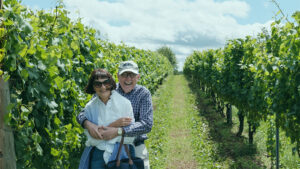Limeburners Creek is a quiet tributary of the Hastings River on the New South Wales mid north coast. Near the junction of the creek and river, sticks mark the location of an abandoned oyster farm.
Near the shore, rocks have been stacked to create a rustic landing. At low tide, these rocks are exposed. Amongst the rocks, there are a few red clay bricks. Each brick features a deeply indented arrow, indicating that the bricks were made by convicts.
Port Macquarie was established as a penal settlement in 1821. By 1825, there were 1100 prisoners in the town’s gaol.
There were four convict brickmaking sites adjacent to natural clay pits at Lake Innes.
We’ll never know how these bricks ended up on an oyster farm on the Hastings River. The first oyster farms on the river date from the later 1870s or early 1880s. Perhaps they were rescued from early brick buildings demolished as the settlement grew.
The Hasting River oyster farms weren’t the first. According to the New South Wales Department of Agriculture, Australia’s commercial oyster farming industry started in 1872 when Thomas Holt created a farm in Gwawley Bay on Sydney’s Georges River.
Even though commercial farming is only 150 years old, Australia’s coastal first nations people regularly harvested wild oysters.
Magnetic Island, off the coast at Townsville is a long way from today’s oyster farming hotspots. There’s a bay, Radical Bay, on the east coast of the island. Even today, access is only by foot or by 4-wheel drive.
Lured by the bay’s remoteness, a man simply known as Clem built a wooden house on sand under the palms at the back of the bay. Clem built the home himself in 1932, hauling timber via horse down the rough track or sailing it around to the beach.
Clem knew every part of the east coast of the island. If you were lucky enough to meet Clem during the forty years he lived in Radical Bay, he might have offered to show you around the island he loved so much.
On a rocky outcrop between Radical Bay and Gowrie Bay, Clem would point out the huge middens of oyster shells and stone tools used to open the oysters. Local Wulgurukaba people camped here for hundreds, even thousands, of years. Oysters were not only a source of nutrition. The shells were turned into tools, worn as fashion, and even turned into fishing hooks.
Jonathan Swift (1667-1745) famously wrote, “It was a brave man who ate the first oyster.” He might have been right. The oyster is an unlikely food. A sharp, rough shell clinging ferociously to rocks. A shell that’s impossible to open and all too fond of inflicting a nasty cut. Then a greyish creamy slippery living thing inside.
And yet, thousands of years ago, someone prized a shell open and swallowed the oyster inside. They clearly liked what he tasted. Demand grew.
King Henri IV of France reputedly ate 300 oysters at a sitting. Around the world, 2 billion oysters are consumed each year.
When we launched Invest Inya Farmer our very first offering was oysters. They were snapped up by our foundation members. We can’t imagine a time when we won’t have at least one offering from an oyster farmer.
From one person’s bravery millennia ago to a 2-billion-a-year passion for oyster lovers worldwide, oysters are a unique part of our history and life today.
Photo by Anima Visual via Unsplash




